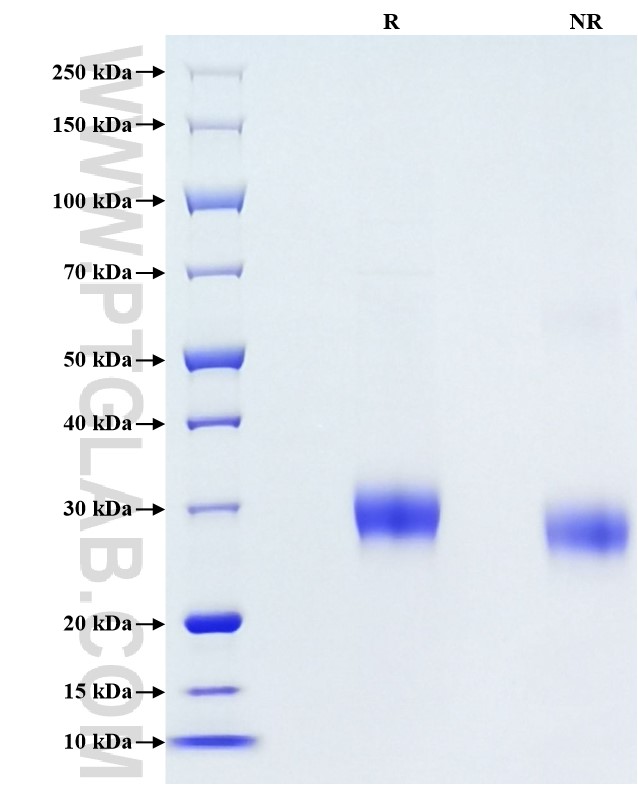Recombinant Human Alpha-1-microglobulin protein (His Tag)
种属
Human
纯度
>90 %, SDS-PAGE
标签
His Tag
生物活性
未测试
验证数据展示
产品信息
| 纯度 | >90 %, SDS-PAGE |
| 内毒素 | <0.1 EU/μg protein, LAL method |
| 生物活性 | Not tested |
| 来源 | HEK293-derived Human Alpha-1-microglobulin protein Gly20-Val203 (Accession# P02760) with a His tag at the C-terminus. |
| 基因ID | 259 |
| 蛋白编号 | P02760 |
| 预测分子量 | 21.6 kDa |
| SDS-PAGE | 27-32 kDa, reducing (R) conditions |
| 组分 | Lyophilized from 0.22 μm filtered solution in PBS, pH 7.4. Normally 5% trehalose and 5% mannitol are added as protectants before lyophilization. |
| 复溶 | Briefly centrifuge the tube before opening. Reconstitute at 0.1-0.5 mg/mL in sterile water. |
| 储存条件 |
It is recommended that the protein be aliquoted for optimal storage. Avoid repeated freeze-thaw cycles.
|
| 运输条件 | The product is shipped at ambient temperature. Upon receipt, store it immediately at the recommended temperature. |
背景信息
Alpha-1-microglobulin (A1M) is also named as Protein AMBP, Bikunin, Trypstatin and Inter-alpha-trypsin inhibitor light chain (ITI-LC). A1M belongs to the lipocalin protein family, a group of structural proteins with a similar one-domain fold that are found in bacteria, plants and animals. A1M is recognized as a physiological antioxidant with powerful cell- and tissue-protective properties. Whereas A1M is a heme and radical scavenger, and a reductase, bikunin is a structural component of extracellular matrix and has protease inhibitor and anti-inflammatory properties. In humans, the majority of A1M is synthesized in the liver, but smaller quantities are also expressed in most other cells in the body. In the blood, equal quantities of two forms of A1M can be found: a free monomeric form and a covalent high-molecular weight complex bound to immunoglobulin A, albumin and prothrombin . Endogenous A1M has also been described to be localized ubiquitously in the dermal and epidermal layers of skin, and in syncytiothrophoblasts, monocytes/macrophages, vascular endothelium and extracellular matrix of placental tissue and extracellular matrix.. A1M is found within the circulation throughout life. Serum levels of A1M are reported to be in the range 15–50 mg/ml with males having slightly higher levels than females. Levels of A1M are, however, known to be influenced by renal and hepatic function; levels increase with impaired renal function and decrease with reduced liver function.
参考文献:
1. Pervaiz S, Brew K. (1985) Science. 228(4697):335-7. 2. Allhorn M, et al. (2002) Blood. 99(6):1894-901 . 3. Gunnarsson R, et al. (2017) Drug Discov Today. 22(4):736-743. 4. Grubb AO, et al. (1983). J Biol Chem. 258(23):14698-707. 5. Berggård T, et al. (1997) Eur J Biochem. 245(3):676-83. 6. Olsson MG, et al. (2011) PLoS One. 6(11):e27505. 7. May K, et al. (2011) Placenta. 32(4):323-32. 8. DeMars DD, et al. (1989) Clin Chem. 35(5):766-72.
